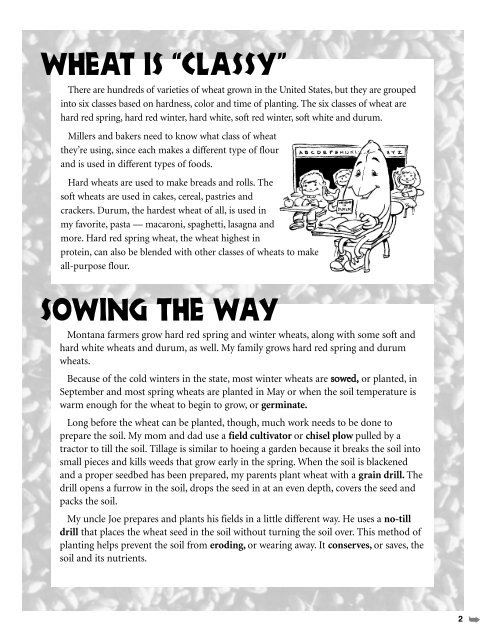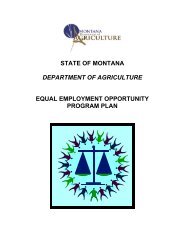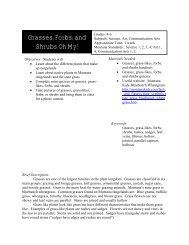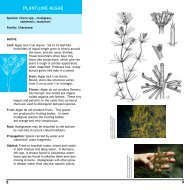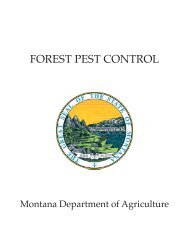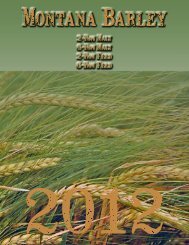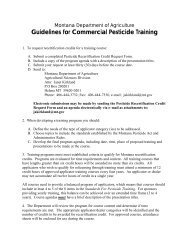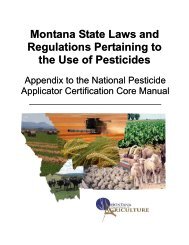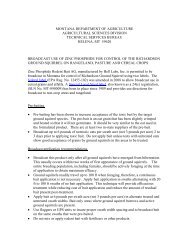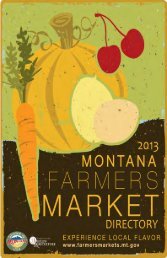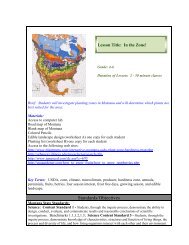The Story of Wheat - Montana Wheat & Barley Committee
The Story of Wheat - Montana Wheat & Barley Committee
The Story of Wheat - Montana Wheat & Barley Committee
You also want an ePaper? Increase the reach of your titles
YUMPU automatically turns print PDFs into web optimized ePapers that Google loves.
<strong>Wheat</strong> is “Classy”<br />
<strong>The</strong>re are hundreds <strong>of</strong> varieties <strong>of</strong> wheat grown in the United States, but they are grouped<br />
into six classes based on hardness, color and time <strong>of</strong> planting. <strong>The</strong> six classes <strong>of</strong> wheat are<br />
hard red spring, hard red winter, hard white, s<strong>of</strong>t red winter, s<strong>of</strong>t white and durum.<br />
Millers and bakers need to know what class <strong>of</strong> wheat<br />
they’re using, since each makes a different type <strong>of</strong> flour<br />
and is used in different types <strong>of</strong> foods.<br />
Hard wheats are used to make breads and rolls. <strong>The</strong><br />
s<strong>of</strong>t wheats are used in cakes, cereal, pastries and<br />
crackers. Durum, the hardest wheat <strong>of</strong> all, is used in<br />
my favorite, pasta — macaroni, spaghetti, lasagna and<br />
more. Hard red spring wheat, the wheat highest in<br />
protein, can also be blended with other classes <strong>of</strong> wheats to make<br />
all-purpose flour.<br />
Sowing the Way<br />
<strong>Montana</strong> farmers grow hard red spring and winter wheats, along with some s<strong>of</strong>t and<br />
hard white wheats and durum, as well. My family grows hard red spring and durum<br />
wheats.<br />
Because <strong>of</strong> the cold winters in the state, most winter wheats are sowed, or planted, in<br />
September and most spring wheats are planted in May or when the soil temperature is<br />
warm enough for the wheat to begin to grow, or germinate.<br />
Long before the wheat can be planted, though, much work needs to be done to<br />
prepare the soil. My mom and dad use a field cultivator or chisel plow pulled by a<br />
tractor to till the soil. Tillage is similar to hoeing a garden because it breaks the soil into<br />
small pieces and kills weeds that grow early in the spring. When the soil is blackened<br />
and a proper seedbed has been prepared, my parents plant wheat with a grain drill. <strong>The</strong><br />
drill opens a furrow in the soil, drops the seed in at an even depth, covers the seed and<br />
packs the soil.<br />
My uncle Joe prepares and plants his fields in a little different way. He uses a no-till<br />
drill that places the wheat seed in the soil without turning the soil over. This method <strong>of</strong><br />
planting helps prevent the soil from eroding, or wearing away. It conserves, or saves, the<br />
soil and its nutrients.<br />
2 ➥


